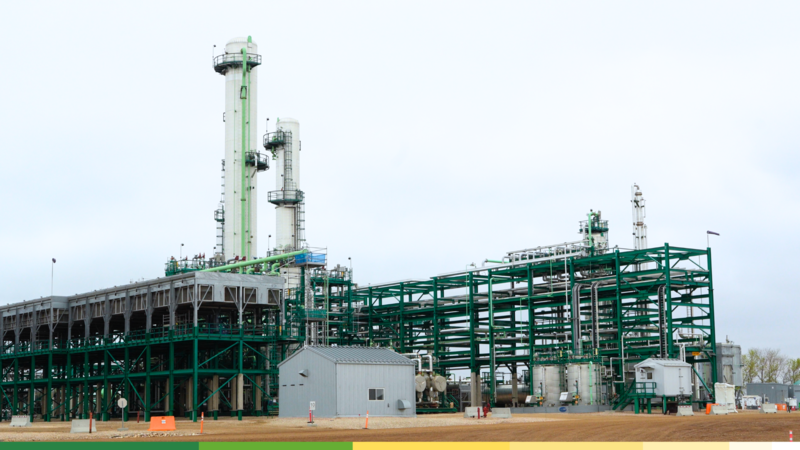Accelerating Hydrogen Storage in Canada's Salt Caverns
Posted on
Dr. Hassan Dehghanpour and his research team.
Two years ago, Dr. Hassan Dehghanpour was eagerly giving tours of a nearly empty lab in the University of Alberta’s Natural Resources Engineering Facility, as he explained the scope of his work: “We’re solving a big challenge for energy storage. We’re going to store hydrogen in underground caverns.”
Fast forward to 2025, Hassan and the Dehghanpour Lab are doing exactly that, in a fully-equipped-and-functioning lab that models Alberta’s bedded salt caverns in Fort Saskatchewan.
“We’re studying the salt caverns qualities in northeastern Alberta for their potential role in the storage of hydrogen,” Hassan explains. “We chose the bedded salt caverns in Fort Saskatchewan because of their reliability when it comes to storing fuels.”
While renewable energy resources, such as solar and wind, offer less carbon-intense ways to generate energy and power the electricity grid, our ability to store large amounts of energy for later use remains a critical piece of the energy security puzzle. Hydrogen is one solution that has been positioned at the centre of energy conversations, particularly for its ability to carry and store energy.
Hassan’s inspiration for hydrogen energy storage came from existing methods of storing energy. For example, Keyera, Hassan’s lead industry partner on this research, has successfully stored natural gas liquids underground in Alberta’s salt caverns for later energy use.
“Keyera has used these caverns to store natural gas liquids for decades,” explains Alex Reed, Lead Cavern Engineer at Keyera’s Fort Saskatchewan facility. “Cavern structure and viability are continually monitored, tested and reinforced as necessary. It’s a very reliable and safe form of storage."

“Unlike other forms of energy storage, there are still a lot of technical challenges with subsurface hydrogen storage at large scale,” explains Hassan. “Using existing field data and core samples shared by our industry partners, we can examine behaviours and characteristics in a more accurate manner.”
Hassan’s lab specializes in examining cavern samples to understand how hydrogen gas will behave by simulating the high pressure, high-temperature conditions of the real-world in the lab. There are obvious differences between storing hydrogen and natural gas liquids, including the chemical composition and molecule size. Hydrogen is also stored as a compressed gas with each cavern able to store up to 2000 tonnes.
Since the caverns are buried up to two kilometers underground, testing the permeability of cavern walls and caprock is necessary for developing future safety standards. Hassan’s team test for different variables, from the geological, structural, and mechanical properties of the cavern walls, to the caprock types and composition, and even chemical reactions that can occur inside caverns. For example, Saniyya Mirza, master’s student at the Dehghanpour Lab, studies how hydrogen gas interacts with microbes and bacteria found in cavern brine water.
“By using DNA sequencing, we see what exists in the brine,” Saniyya shares. “Some bacteria produce methane, which causes impurities, and others produce a dangerous hydrogen sulfide gas when they consume hydrogen, which we definitely want to avoid.
“Part of my job is to look at brine under conditions that mimic those in the field, so around 3000 psi and 30°C. I note things like pH analysis, compositional analysis, and gas chromatography to understand the biogeochemical reactions.”

Field conditions mimicked in the lab are shaped by the data provided to Hassan’s team by several industry partners. As an Accelerator Project, industry collaboration is a central part of Hassan’s work, and being based out of the University of Alberta means the team has access to two hydrogen energy innovation hubs: the Edmonton Region Hydrogen Hub and the recently launched Calgary Region Hydrogen Hub.
If field testing is successful, Hassan’s research will be a major step toward a carbon-neutral energy future in Canada. Beyond Alberta, Hassan and his team are also working with industry partners in Newfoundland to understand how hydrogen can be stored in domal salt caverns, as opposed to the bedded salt caverns found in Alberta.
With pilot field trials underway and industry support in place, the Dehghanpour Lab is paving the way for practical, scalable hydrogen storage. At the same time, Hassan’s research efforts are also helping inform and support the development of national safety standards, ensuring that commercial-scale hydrogen storage methods can be adopted responsibly and sustainably across Canada.
As a clean energy future becomes the present, Hassan and the Dehghanpour lab are helping ensure that hydrogen is part of the conversation and has a place to stay until we need it.
Watch Hassan’s Accelerator Project on Youtube.
This story is part of Future Energy System’s Accelerator Project Series. For more information on the Accelerator Projects, click here. To stay up to date with this series, subscribe to our monthly newsletter and follow FES on social media.
Further Reading:
Field Trial of Hydrogen Storage in Canadian Bedded and Domal Salts: Future Energy Systems